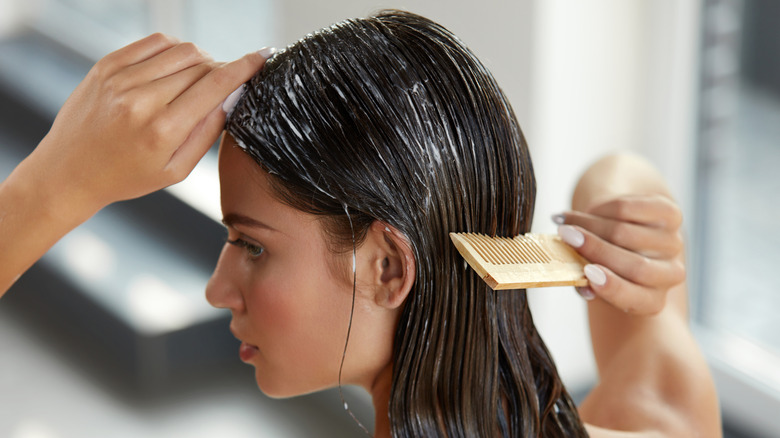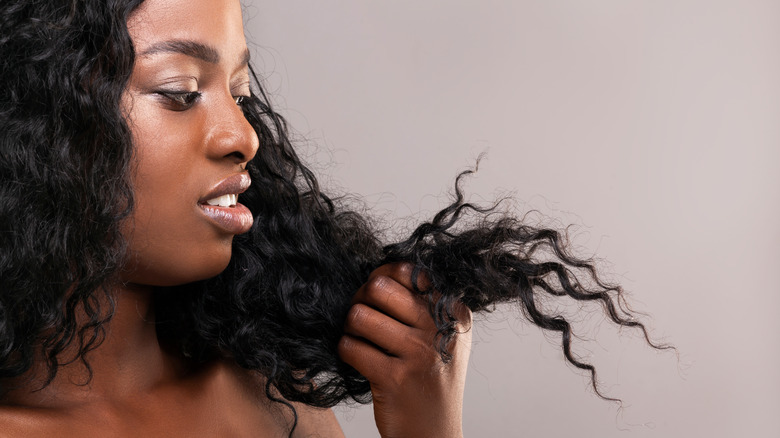What Happens When You Use Too Much Conditioner On Your Hair?
If you have a standard haircare routine that involves shampoo followed by conditioner, you probably already know the benefits of the latter. For curly or dry hair, conditioners often become a saving grace, and for good reason. They make styling effortless and also make your locks look great. Conditioners come in a variety of types — leave-in, rinse-out, volumnizing, deep-conditioning, dry-conditioning — and they all essentially work by locking in moisture and making your hair appear soft and shiny.
As board-certified dermatologist Adam Friedman shared with Allure, "Conditioner refortifies the cuticle with a protective coating, allowing the hair to keep growing and not break easily." If you've been using conditioner all your life, you also know how effortless it becomes to detangle your tresses. In fact, when you stop using a conditioner, your hair often becomes brittle and unmanageable.
However, as with almost anything in the beauty industry, too much of something can be bad for you. This is true of conditioners too. If you notice your locks are looking extra greasy and flat all of a sudden, too much conditioner could be the culprit. Here's what happens when you use too much conditioner on your hair.
Your hair becomes greasy and lifeless
Putting more than the recommended amount of conditioner on your hair can leave it feeling oily and lifeless. Your hair might also feel too soft and glossy to style and look like it's lost volume. With fine hair, too much conditioner can manifest in stringiness too.
Mizani artist Ashley Jackson likens over-conditioned hair to overcooked spaghetti. "When it hasn't received water, the noodle is hard and susceptible to breakage. With the right amount of moisture, the noodle is still strong but much more pliable and has better elasticity ... However, when the noodle is overcooked, it can become limp and mushy," she told Hair. Overcooked spaghetti can also be more prone to breakage, and the same can be said for hair that has too much conditioning product on it.
Since one of the purposes of conditioning is to provide an extra layer of protective moisture to your hair strands, over-conditioning can actually do too much of this. This results in other hair nourishing treatments — such as hair oil — not being able to penetrate that coating to do their intended job. If you're wondering what the right way to condition your hair is, there are some things to keep in mind.
Think about hair type and length, and the amount of conditioner you're using
A good rule of thumb is to follow the instructions on the bottle — different kinds of conditioners will require different leave-in times before you rinse the product off. For long hair, one or two pumps would suffice, and for shorter tresses, even less. In fact, less is more here and before you apply the conditioner, make sure you squeeze the water out of your tresses as much as possible to avoid putting product onto dripping wet hair. This will only dilute the conditioner and make you feel like you need more product in your locks.
While thick and curly hair might require more conditioner, with thin hair, the key is to avoid the scalp and condition your tresses from mid-end. How you treat your hair also depends on which conditioner you're using. If you're applying a leave-in conditioner, opt for about two sprays with fine hair and four with thick tresses. You can follow the same ratio with short and long hair respectively. Check with your hairstylist if you have any doubts about how much product you should be using.
As for frequency, many hairstylists would likely tell you it's perfectly fine to condition your hair every time you shampoo it. But if you feel like your hair is especially limp and lifeless because of over-conditioning, try using a clarifying shampoo once in a while to remove excess product buildup.

